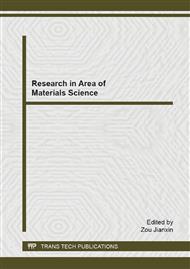p.331
p.336
p.340
p.346
p.351
p.356
p.360
p.366
p.371
Quantitative Calculation of Polynuclear Aluminum Content in the Forced Hydrolysis-Polymerization Course of Aluminum (III) Salt Solutions
Abstract:
According to the results of potentiometric titration of aluminum salt solutions under the moderate slow rate of injecting base and the three critical feature points on its titration curves, at the same time, using the self-contained Boltzmann's equation of Origin software fitting the curve, the quantitative formula of poly-aluminum content have been given. This formula can calculate conveniently the polynuclear aluminum content in the forced hydrolysis-polymerization process. The value of pattern calculation coincides with that of the Al-ferron timed spectrophotometry assay, which offers a kind of new method for studying the course and the quantitative determination of Al (III) salt solutions in simple water systems.
Info:
Periodical:
Pages:
351-355
Citation:
Online since:
April 2015
Authors:
Price:
Сopyright:
© 2015 Trans Tech Publications Ltd. All Rights Reserved
Share:
Citation:


